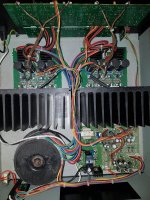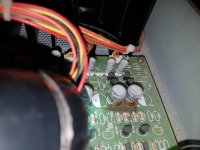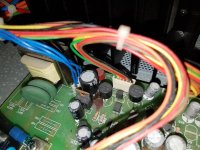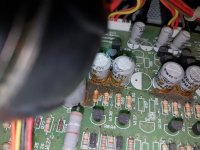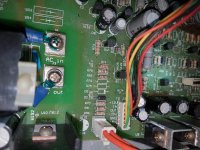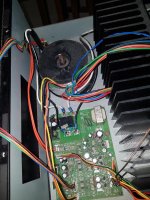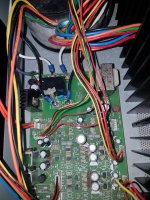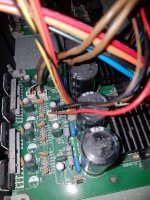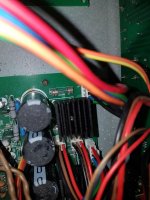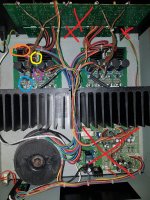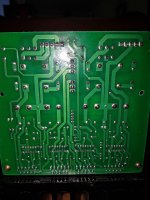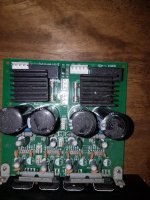What would you do?
I scored a SpeakerCraft BB835. It has 4 pairs of LM3886 amplifier chips attached to 2 LARGE heat sinks. So 2 sets of 4 LM3886 amp chips. There is a problem with the power supply board. Most of the Caps have leaked out. Pics attached below.
What would you do?
1 Part out system to two 4 chip amplifiers with new power supplies?
2 Replace leaking caps?
3 Replace power supply board?
4 Other
I scored a SpeakerCraft BB835. It has 4 pairs of LM3886 amplifier chips attached to 2 LARGE heat sinks. So 2 sets of 4 LM3886 amp chips. There is a problem with the power supply board. Most of the Caps have leaked out. Pics attached below.
What would you do?
1 Part out system to two 4 chip amplifiers with new power supplies?
2 Replace leaking caps?
3 Replace power supply board?
4 Other
The power supply for the amps section is obviously on the amps pcb and directly fed from the transformer, not on that board. This board seems to feed the low level/protection sections.
One option might be to simplify everything by removing that damaged board, wiring directly the transformer to the mains (with a fuse of course) and running inputs directly to the lm3886 boards. But it's difficult to say without more pics of the lm3886 section and without knowing what functionnalities you want to preserve.
One option might be to simplify everything by removing that damaged board, wiring directly the transformer to the mains (with a fuse of course) and running inputs directly to the lm3886 boards. But it's difficult to say without more pics of the lm3886 section and without knowing what functionnalities you want to preserve.
google says the SpeakerCraft BB835 is an 8 channel amplifier. If the amp works you can use it as is for a 7 channel + sub woofer home theatre setup. Most likely the power transformer is still good. You can look for Parallel Bridged circuits and build a two channel amp from the 8 chips. you can build a 5 channel amp and parallel the remaining 3 chips to drive a 2 ohm subwoffer etc. It all depends on your skills and determination.
I would leave as is, which is perfect for the application needed.
You already have 8 separate identical amplifiers, mix and match as needed using existing inputs and outputs.
If you disassemble it "just to use the parts" , you will end up with an un used half built half disassembled boat anchor, occupying space and doing nothing.
At least that´s what happens with a ton of similar projects.
The most expensive and useful component there is the power transformer, and you seem not too keen on using it.
You already have 8 separate identical amplifiers, mix and match as needed using existing inputs and outputs.
If you disassemble it "just to use the parts" , you will end up with an un used half built half disassembled boat anchor, occupying space and doing nothing.
At least that´s what happens with a ton of similar projects.
The most expensive and useful component there is the power transformer, and you seem not too keen on using it.
My guess is that the board with the caps having brown leakage around them is not a Power Supply board, but a muting/protection type of circuit. Without the schematic I can't tell what it does. But it looks like the larger caps on the amp PCBs are the power supplies, or at least the smoothing caps for them. You might looks for schematics online to confirm.
One option would be to part out the two amp PCBs with 4 LM3886 ICs each and build a pair of 3- or 4-way active speakers. You will need new transformers to power the amp boards, but it might be a fun project if you do any loudspeaker DIY.
I'm currently taking this approach with a couple of Crestron 16-channel amps: these come with eight 2-channel class-AB amp boards with onboard heat sinks. You can part out the amp into sets of 2-channel boards. There are two large transformers, so I could do two 8-channel systems with the MFG transformers or I can buy additional transformers and use one or two amp boards per transformer for a 2-, 3-, or 4-way active system.
One option would be to part out the two amp PCBs with 4 LM3886 ICs each and build a pair of 3- or 4-way active speakers. You will need new transformers to power the amp boards, but it might be a fun project if you do any loudspeaker DIY.
I'm currently taking this approach with a couple of Crestron 16-channel amps: these come with eight 2-channel class-AB amp boards with onboard heat sinks. You can part out the amp into sets of 2-channel boards. There are two large transformers, so I could do two 8-channel systems with the MFG transformers or I can buy additional transformers and use one or two amp boards per transformer for a 2-, 3-, or 4-way active system.
Last edited:
Edit: the first step would be to replace the leaking caps and see if it works as is. If not see below.
Without the service manual, it's difficult to say exactly but at first sight...
Remove the backplane pcb, the "ps" pcb (probably sofstart, switch on and DC protection). Add 8 rca and 8 speaker connectors to the back.
Tie the AC mains input directly to the transformer (via a fuse and a properly rated switch). You'll have to check which wire is what.
The orange connector is probably the AC connection from the transformer to the lm3886 supplies. The small heatsinks probably are there for the diode bridges.
The yellow connectors probably are the speakers output. Tie output connectors directly there. You'll have to check which wire is what.
The blue connectors are probably the inputs. Tie wires from there to your input rca. You'll have to find which wire is what but also the input impedance of the amp and how the lm3886 are wired (inverting, non inverting, etc).
The violet connectors are the tricky ones. Probably some kind of DC sensing. Probably can be left open... but no guarantee.
This is all guessing. It would be kind of trivial if you're experienced with amps. If not, you might mess up easily...
Here are a few more pictures with wires pulled out of the way. What would you do to simplify? I dont need ANY of the fancy stuff in the unit. I just want some amplifiers for a home theater setup.
Without the service manual, it's difficult to say exactly but at first sight...
Remove the backplane pcb, the "ps" pcb (probably sofstart, switch on and DC protection). Add 8 rca and 8 speaker connectors to the back.
Tie the AC mains input directly to the transformer (via a fuse and a properly rated switch). You'll have to check which wire is what.
The orange connector is probably the AC connection from the transformer to the lm3886 supplies. The small heatsinks probably are there for the diode bridges.
The yellow connectors probably are the speakers output. Tie output connectors directly there. You'll have to check which wire is what.
The blue connectors are probably the inputs. Tie wires from there to your input rca. You'll have to find which wire is what but also the input impedance of the amp and how the lm3886 are wired (inverting, non inverting, etc).
The violet connectors are the tricky ones. Probably some kind of DC sensing. Probably can be left open... but no guarantee.
This is all guessing. It would be kind of trivial if you're experienced with amps. If not, you might mess up easily...
Attachments
Last edited:
Someone has to say this.... walk to the nearest dumpster and deposit the whole thing. I know there is a cult following with chip amps. The truth of the matter is they are a cheap way for the average guy to put a amplifier together. If your hell bound on having a set of chip amps I suggest that you check out your nearest Jukebox dealer for some power amp modules and power supply. Generally you can get several 300 watt per channel stereo modules along with a subwoofer module for little or nothing.
I would suggest saving your money attend yard sales and hope to purchase someones thrown out Adcom, Crown, or Yamaha. You can generally get those cheap because they are of low to middle quality.
Note... the brownish (dried glue) is what your showing in the pictures that your thinking that the caps have leaked.
I would suggest saving your money attend yard sales and hope to purchase someones thrown out Adcom, Crown, or Yamaha. You can generally get those cheap because they are of low to middle quality.
Note... the brownish (dried glue) is what your showing in the pictures that your thinking that the caps have leaked.
Tried a few suggestions
I finally had some time. Tried a few suggestions.
Powered up. Nothing. Fuse pop.
Cleaned all boards. New fuse. Front panel lights come on. Channel error lights on then go out. Tried all input options (Bus, Aux, Line in). No sound except when disconnecting input. Loud thud on woofer. Tried boosting input with a cmoy. Nothing.
Powered straight to toroidal by passing front power board with input board and output board attached. Nothing except when input disconnected, loud thud. "violet" tried connected and disconnected. No change.
Powered straight to toroidal with input panel disconnected. Input straight to "blue" input. Output board connected. Nothing except when input disconnected, loud thud.
Powered straight to toroidal with input panel disconnected. Input straight to "blue" input. Output board disconnected. Speakers straight to "yellow" speakers out. Nothing except when input disconnected, loud thud.
Didn't try "BURNEDFINGERS" suggestion. Yet.
I finally had some time. Tried a few suggestions.
Powered up. Nothing. Fuse pop.
Cleaned all boards. New fuse. Front panel lights come on. Channel error lights on then go out. Tried all input options (Bus, Aux, Line in). No sound except when disconnecting input. Loud thud on woofer. Tried boosting input with a cmoy. Nothing.
Powered straight to toroidal by passing front power board with input board and output board attached. Nothing except when input disconnected, loud thud. "violet" tried connected and disconnected. No change.
Powered straight to toroidal with input panel disconnected. Input straight to "blue" input. Output board connected. Nothing except when input disconnected, loud thud.
Powered straight to toroidal with input panel disconnected. Input straight to "blue" input. Output board disconnected. Speakers straight to "yellow" speakers out. Nothing except when input disconnected, loud thud.
Didn't try "BURNEDFINGERS" suggestion. Yet.
Attachments
- Status
- This old topic is closed. If you want to reopen this topic, contact a moderator using the "Report Post" button.
- Home
- Amplifiers
- Power Supplies
- 8 LM3886 Amplifiers - What would you do?
